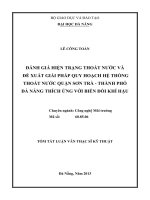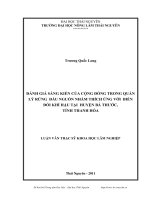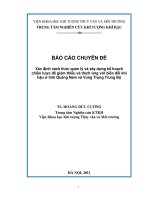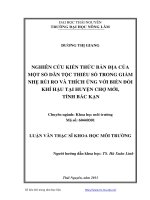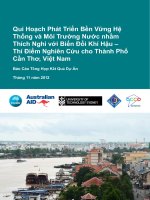Quản lý quy hoạch thoát nước giảm thiểu ngập úng cho các đô thị vùng duyên hải bắc bộ thích ứng với biến đổi khí hậu tt tiếng anh
Bạn đang xem bản rút gọn của tài liệu. Xem và tải ngay bản đầy đủ của tài liệu tại đây (856.24 KB, 27 trang )
MINISTRY OF EDUCATION AND TRAINING
MINISTRY OF CONSTRUCTION
HANOI ARCHITECTURAL UNIVERSITY
NGO HUY THANH
MANAGEMENT OF DRAINAGE PLANNING
TO MITIGATE INUNDATION
IN THE NORTHERN COASTAL URBAN AREAS
AND ADAPT TO CLIMATE CHANGE
MAJOR: URBAN AND CONSTRUCTION MANAGEMENT
CODE: 62.58.01.06
ABSTRACT FOR PHD THESIS OF
URBAND AND CONSTRUCTION MANAGEMENT
Hanoi, 2019
The thesis is completed at the Ha Noi Architectural University
Academic Advisor: Associate Professor. PhD. Mai Thi Lien Huong
Thesis reviewer No. 1:
Thesis reviewer No. 2:
Thesis reviewer No. 3:
This thesis was presented at the PhD Thesis Committee at the Ha Noi
Architectural University.
At ……. on ……. ……. 2019
The thesis can be found at:
1. The National Library.
2. The Library of the Ha Noi Architectural University.
1
A. INTRODUCTION
Rationale
The topic was selected for the following reasons: (i) Climate
change (CC) is in the top challenges today. According to World Bank
(2011), Vietnam is one of the 5 countries that will be hardest hit by
climate change and sea level rise (SLR); (ii) Eight urban areas of grade
III or higher under the jurisdiction of the provincial government in the
Northern Coastal Region (NCR) have been clearly suffering from the
impacts of climate change such as rain, storm, SLR and the
combination of rain, storm, river flood and high tide; (iii) While other
coastal urban areas in the country are often flooded by tides, Quang
Ninh province, with mountains and hills making up 90% of total
natural area and large percentage of forest land, flood often comes
from upstream area; while Thai Binh, Nam Dinh and Ninh Binh
provinces with slightly slope terrain and large but diminished area of
trees and water surface (detention reservoirs) are facing the inundation
due to heavy rain and the ground being unable to absorb excess water;
(iv) In the general urban planning proposal, the water drainage
planning component has not taken into account the climate change
factors and plans to mitigate inundation are still missing; (v) The
absence of a system of legal documents and specific guidelines related
to inundation mitigation and climate change leads to many obstacles
and inconsistency in drainage planning management; (vi) Many
scientific studies have proposed ways to address flooding in urban
areas in the context of the climate change; however, it is still difficult
to apply them in reality; (vii) Cam Pha City is selected as the study site
for its diverse topography and proximity to the sea. According to the
RCP 4.5 scenario in 2016, the change of precipitation in the period
2
2016-2035 for Quang Ninh province in general and Cam Pha City in
particular would increase by 20.4%, ranking second in the whole
country (only behind Hai Phong City), and sea level rise in the Mong
Cai - Hon Dau area is 13 cm (8-18), respectively. It can be said that
this is the area most affected by climate change within the Northern
Coastal Region.
Research objectives
- Evaluate the current state of drainage planning and inundation
mitigation management and impacts of climate change in the Northern
Coastal Region.
- Propose solutions to manage drainage planning to mitigate
inundation in the Northern Coastal urban areas to adapt to climate
change.
- Apply research results to Cam Pha City, contributing to
improving the feasibility of the proposed solutions in practice.
Research subjects and scope
Research subjects:
- Management of drainage planning to mitigate urban flooding
and adapt to climate change. In which, focusing on researching issues
related to surface water drainage system.
Research scope:
- Location: urban areas of grade III or higher under the jurisdiction
of the provincial government in the Northern coastal region, especially
Cam Pha city.
- Timeframe: Orientation to 2030.
Research methodology
The thesis uses 07 main research methodologies including:
Investigation and survey; Summarization and analysis; Expertise;
3
Inheritance; Comparison; Forecast; Mapping, chart, map overlaying,
modeling (using GIS - geographic information system).
Scientific and practical significance of the topic
- Scientific significance: The research results of the thesis will
help concretizing and adding scientific theories to the management of
drainage planning to mitigate inundation for Northern Coastal Region
urban ả to adapt to climate change.
- Practical significance: + The thesis recommendations will
contribute to improving the policy and mechanism in the management
of drainage planning to mitigate inundation for Northern Coastal
Region urban areas and can be applied in practice.
+ The thesis can be used as reference
for research and training in related fields.
Concepts or terminologies
The thesis uses some basic concepts and terminologies in the fields of
drainage planning management, flooding, climate change, etc. in
relation to the research topic.
Structure of the thesis
Introduction
Main content includes 3 chapters:
Chapter 1: Overview of drainage planning management to mitigate
inundation and climate change.
Chapter 2: Scientific basis for management of drainage planning to
mitigate inundation for urban areas in the Northern Coastal Region to
adapt to climate change.
Chapter 3: Solutions to management of drainage planning to mitigate
inundation in the Northern Coastal Region urban areas to adapt to
climate change.
4
Conclusion and recommendations
List of references (54 documents)
Appendix (25 pages)
B. MAIN CONTENT
CHAPTER
1:
OVERVIEW
MANAGEMENT
TO
OF
DRAINAGE
MITIGATE
PLANNING
INUNDATION
AND
CLIMATE CHANGE
1.1. Overview of drainage planning management, inundation
mitigation and climate change in some countries around the world
1.1.1. Overview of drainage planning management and inundation
mitigation in some countries around the world: Drainage planning
management and inundation mitigation include risk assessment, flood
mapping, and the application of information technology.
1.1.2. Overview of the impacts of climate change in some regions of the
world: Sea level rise; temperature and precipitation change, other changes,
and extreme weather.
1.1.3. General comments: Drainage planning management and inundation
mitigation can no longer be involved with separate urban areas. Climate
change, which includes increasing precipitation, is one of the main causes
of inundation and flooding.
1.2. Introduction about the Northern Coastal Region
1.2.1. Natural conditions: heavy precipitation, diurnal tide, very diverse
terrain.
1.2.2. Economic and social conditions: relatively high population density,
industry and service sectors make up the major part of the region
economy.
1.2.3. General comments
5
+ The Northern part of the region, which consists of urban areas in Quang
Ninh province, has mountainous terrain and large forest area. Inundation
is often caused by flash flood.
+ The Southern part, which consists of Thai Binh, Nam Dinh and Ninh
Binh provinces, has slightly slope terrain, large green area and water
surface (detention reservoirs). These areas are meant to absorb rainwater
but are diminished, which results in inundation.
1.3. Current drainage system and inundation
1.3.1. Current drainage system: Most urban areas use the common
drainage system, which has downgraded.
1.3.2. Current inundation in the Northern Coastal Region and causes:
Inundation is increasingly popular, for both subjective and objective
reasons.
1.4. Current drainage planning management
1.4.1. Ongoing drainage projects
All cities under the jurisdiction of the central government have specialized
plans for drainage, the other urban areas have drainage plans as part of
their urban planning.
1.4.2. Current situation of the drainage planning management
The process, from defining missions to publishing planning proposals, has
not taken into account climate-change-related factors. The timeframe,
duties, functions and responsibilities of each stakeholder are unclear.
1.4.3. Current construction management in compliance with drainage
planning
The management of drainage system construction and investment is still
struggling due to capital shortage; The control of ground level and
connection to related projects is still inconsistent; inspection work has
been decentralized.
6
1.4.4. Current structure of managing drainage planning
The drainage work and drainage planning is under the Central
Government’s administration throughout the country.
1.4.5. Current situation of sustainable drainage, inundation mitigation
and adaptation to climate change: Currently, it is not popular.
1.4.6. Some simulation tools used in drainage planning management
The SWMM Model - Storm Water Management Model; MIKE modelling
set; GIS - geographic information system.
1.4.7. Community participation in drainage planning management to
mitigate inundation
The community so far has participated in only defining missions and
preparing planning. There are no specific regulations on gathering public
comments as part of the drainage planning management.
1.4.8. General comment
- Specialized drainage planning are only available for cities under the
jurisdiction of the central government. Other remaining urban areas do not
have specialized drainage planning but included in general urban
planning. New technologies such as GIS, flood mapping regarding to
climate change and sea level rise scenarios have not been applied in
planning.
- There is a lack of legal document system and specific guidelines related
to climate change and inundation mitigation, both for drainage planning
management and implementation, from defining missions to publishing
planning proposals.
- The management, utilization and operation of the drainage system are
still included in other areas such as water supply and environment; There
is no specialized committee or team to manage the sector of drainage and
inundation mitigation.
7
- The construction in compliance with the drainage planning in each
locality is under the management of different units without consistency.
Determining the construction level between projects remains a problem.
In particular, other factors affecting the determination of construction
level have not been taken into accounts, such as climate change and sea
level rise.
- The model of sustainable drainage is still alien and has virtually not been
implemented in Northern Coastal Region urban areas, nor has it been
integrated right from the first steps of planning.
- GIS is considered an effective simulation tool for flood mapping that
takes into account climate change due to the ability to map overlaying and
create thematic maps with relevant planning information.
- Community participation is still low.
- The elements related to climate change and inundation mitigation have
not been mentioned in the management of drainage planning.
1.5. Current impacts of climate change
1.5.1. Impact of climate change in some regions in Vietnam
Within this thesis, the author focuses on analyzing the impacts of climate
change in the three coastal areas of Vietnam, meaning the Northern
Region, the Central Coastal Region and the Mekong River Delta.
1.5.2. Impacts of climate change in Northern Coastal Region urban areas:
Impacts due to increasing precipitation and sea level rise; Impacts due to
storms, tropical cyclones, floods; Impacts due to flash floods, mud and
rock floods and landslides; Impacts due to temperature change.
1.5.3. General comments
Table 1.1: Evaluation of climate change’s impacts in some areas in Viet
Nam
8
Storm,
tropical
cyclone
Flood
Flash flood,
mud and rock
floods
Landslide
Moderate
(Northern
Coastal
Region has
very
high
risks)
High
Moderate
(Northeast
area and
Quang
Ninh
province
have high
risks)
Moderate
(Northeast
area has very
high risks)
High (Red
River Delta
has
low
risks)
Low
Moderate
Moderate
(Thua Thien
Hue – Binh
Dinh
have
very
high
risks)
High
(Thanh
Hoa –
Ha Tinh
have
very
high
risks)
High
Low
Low (Thua
Thien Hue
–
Quang
Ngai have
very high
risks)
Low
Very high
Low
Low
Very high
Low
High
Moderate
Sea level
rise
Increasing
precipitation
Low
(Northern
Coastal
Region
has high
risks)
Central
Coastal
area
Mekong
River
Delta
Northern
area
Increasing
temperature
(Evaluation ranges from Low, Moderate, High to Very High)
The Northern Coastal Region is seriously affected due to
increasing precipitation (highest in the country - according to the
climate change scenario RPC4.5 in the period from 2016 to 2050) and
flash floods, mud and rock floods (for Quang Ninh province).
1.6. Other related studies
1.6.1. Scientific studies and theses: Not local-specific, some theses
have not taken into account the climate change factors.
1.6.2. Drainage planning and inundation mitigation projects: Fail to
propose practical models.
1.6.3. Evaluation
The thesis summarized and evaluated 3 scientific projects, 2 doctoral
theses, 4 studies in the world, 3 projects - proposals - reports on:
- Drainage and inundation mitigation on a large scale (regional scale,
river basin, etc.).
9
- Drainage and inundation mitigation for each specific locality.
- Climate change and sea level rise.
- Sustainable rainwater drainage model.
1.7. Thesis focused issues
Based on the evaluation, the author chose to study and resolve some of
the following issues in drainage planning management:
- Scientific basis for the management of drainage planning, inundation
mitigation and climate change.
- Application of sustainable drainage model.
- The process from defining missions to publishing planning proposal
for drainage planning projects to mitigate inundation and adapt to
climate change.
- Solutions related to the management of drainage planning to mitigate
inundation and adapt to climate change.
- Improve policy, managers’ capacity and community participation.
- Application of GIS technology in flood mapping.
- Application of the thesis outcomes in drainage planning management
in Cam Pha City.
CHAPTER 2: SCIENTIFIC BASIS FOR MANAGEMENT OF
DRAINAGE PLANNING TO MITIGATE INUNDATION FOR
URBAN AREAS IN THE NORTHERN COASTAL REGION TO
ADAPT TO CLIMATE CHANGE
2.1. Rationale for drainage planning management to mitigate
inundation in Northern Coastal Region urban areas and adapt to
climate change
2.1.1. Planning, drainage planning management and integrating
climate change factors to mitigate inundation: includes basic
knowledge about drainage planning for urban areas, drainage planning
10
management for urban areas; Climate change impacts and inundation
mitigation added to and mainstreamed into drainage planning
proposals such as Climate Change and SLR Scenario 2016 for
Vietnam, Four steps in responding to climate change, Drainage
planning for inundation mitigation in urban areas.
2.1.2. The impacts of climate change on inundation, flooding, and
urban drainage systems: Changes in inputs and margin conditions
when calculating and building; increasing likelihood of destruction due
to extreme climate events.
2.1.3. GIS and its application in planning management: Providing a
systematic view and make it easy to do planning and support the
decision-making process in management
2.1.4. The model for sustainable drainage and inundation mitigation:
Introduce concepts, principles, efficiency, benefits, levels and
functions of components that constitute a sustainable drainage model.
Table 2.2: Control levels of a sustainable rainwater drainage
system
11
Basically, instead of quick drainage of surface runoff in urban areas
through the system of canals, ditches or underground sewers, the
sustainable drainage model slows down the aforementioned process
with technical solutions, in which, full capacity of the natural
ecosystem in storing and improving water quality is used, with the aim
of bringing the most benefits to people and the living environment.
2.1.5.
The
organizational
structure
for
drainage
planning
management: requirements and principles in management.
2.1.6. Community participation in the management of drainage
planning and inundation mitigation: roles, possible areas of
participation and effectiveness.
2.2. Legal basis for urban drainage planning management
2.2.1. Legal documents on drainage planning management: Urban
Planning Law (No. 01/VBHN-VPQH); Construction Law (No.
50/2014/QH13);
Law
on
Environmental
Protection
(No.
55/2014/QH13); Law on Water Resources (No. 17/2012/QH13).
2.2.2. By-law document on drainage planning management: Decree
44/2015/ND-CP; Decree No. 80/2014/ND-CP; Decree 37/2010/NDCP; Circular 12/2016/TT-BXD.
2.2.3. System of standards and regulations on drainage planning
management: QCVN 07-2:2016/BXD; QCXDVN 01:2008/BXD;
TCVN 7957:2008
2.2.4. Approved planning projects related to drainage planning in
Northern Coastal Region urban areas: The part on drainage planning
research has been quite sufficient while the part on the impacts of
climate change and sustainable drainage solution is still missing.
2.3. International and Vietnam experiences in drainage planning
management to mitigate inundation and adapt to climate change
12
2.4.1. Experience in Vietnam: Solutions to manage drainage and
flooding in Vinh City - Nghe An Province; Quy Nhon City; Ecopark
urban area, Hung Yen - Surface rainwater management system.
2.4.2. International experience: Bangkok, Thailand - Flood control
center; Japan; England and Wales - Managing surface runoff; US Sustainable drainage model at George Washington University
CHAPTER 3: SOLUTIONS TO MANAGEMENT OF
DRAINAGE PLANNING TO MITIGATE INUNDATION IN
THE NORTHERN COASTAL REGION URBAN AREAS TO
ADAPT TO CLIMATE CHANGE
3.1. Viewpoints, objectives and principles applied to the
management of drainage planning to mitigate inundation for
Northern Coastal Region urban areas to adapt to climate change
3.1.1. Viewpoints
(i) Drainage Planning Management to mitigate inundation is associated
with forecasting inundation and assessing the impacts of climate
change. (ii) Using sustainable drainage planning model as an additional
solution to inundation mitigation in drainage planning management.
(iii) Using advanced science technology in drainage system
construction and planning management. (iv) Establish “Committee on
Drainage Planning Management and Inundation Mitigation for the
Northern Coastal Region” to address related issues. (v) The community
must participate in the management of drainage planning to mitigate
inundation and adapt to climate change.
3.1.2. Objectives
(i) Integrating climate change factors and sustainable drainage model
in drainage planning management. (ii) Proposing new solutions in the
management of drainage system construction. (iii) Applying GIS in
inundation mapping, taking into account climate change factors. (iv)
Enhancing managers’ capacity in drainage planning; strengthening the
relationship and coordination among localities in the region as well as
13
direct management agencies. (v) Defining clearly the community
participation in drainage planning management.
3.1.3. Principles
(i) In compliance with Decision No. 589/QD-TTg dated April 6, 2016
on approving the revised development orientations for urban and
industrial park drainage system in Viet Nam to 2025 and vision to
2050. (ii) Maximize the use of detention reservoirs. (iii) Given the
reality, make the best of the current renovated drainage system. For
new areas, the construction of the drainage system as a shared,
completely separate and semi-separate one as well as the application of
a sustainable drainage system must be based on each urban area’s
specific condition. (iv) The formulation, appraisal and approval of
drainage planning must comply with and inherit from relevant
planning that had been approved by the authorities, in accordance with
the existing legal procedures. (v) The construction management must
proceed from long-term planning projects and construction phases, at
the same time, taking into account the economic, technical and sanitary
factors to ensure the optimization of human resources and finance. (vi)
Proposed management models must be practical and suitable with the
context of the region as well as each locality; The management
structure model must match its roles, functions, duties and authorities
assigned by the Government; there must be sufficient qualified
personnel to promptly solve problems arising during implementation,
investment and construction.
3.2. Proposed solutions for drainage planning management to
mitigate inundation and adapt to climate change
3.2.1. The sustainable drainage management model solution
Help solving the hydrological impacts due to increasing precipitation
in the Northern Coastal urban areas.
a. Applying the sustainable drainage model to the road network
b. Integrating the sustainable drainage model into the functions of
using civil land.
14
Table 3.1: The management of sustainable drainage model construction by functions of using civil land
Land use
Green area
Public land
Living area
Urban Living Urban Living Semi-detached
Complex
Apartment
Villas Villages
area
unit
area
unit
houses
buildings
No
1
2
3
4
5
Green roof
Green wall
Underground water tank
Tree planter
Bioretention area (rain garden)
6
7
8
9
10
Pervious surface
Filter drain
Swales
Botanical-covered channel
Filter strips
X
X
X
X
X
X
X
X
X
Control solutions at source
X
X
X
X
X
X
X
X
X
X
X
Control solutions on surface
X
X
X
X
X
X
X
X
X
X
X
X
Land for
schools and
other non-civil
purposes
X
X
X
X
X
X
X
X
X
X
X
X
X
X
X
Control solutions in region
11
12
Wetland
Balancing pond
X
X
3.2.2. Solutions for the process from establishing mission to publishing planning for drainage planning
project to mitigate inundation and adapt to climate change
15
Table 3.1: Solutions for the process from setting up missions to
publishing planning for drainage planning project to mitigate
inundation and adapt to climate change
16
3.3. Proposed solutions that are related to drainage planning
management to mitigate inundation and adapt to climate change
3.3.1. Drainage management by regions and river basins: For the main
drainage axes of the region and for key irrigation works such as
upstream reservoirs, spillways and drainage pumping stations.
3.3.2. Management and development of buffer zones to protect coastal
and riverside urban areas: Cooperate with the Ministry of Natural
Resources and Environment to develop plan to protect and plant new
watershed forest systems to reduce the likelihood of flash flood and
landslide, affecting the downstream urban drainage system (Solution
specifically for Quang Ninh area).
3.3.3. Management and development of lake systems: Lakes in the
region and sub-regions; Detention reservoirs in urban areas (Solution
dedicated to Thai Binh, Nam Dinh and Ninh Binh provinces).
3.3.4. Management of ground level: Factors such as tide level,
inundation level rise due to storm, sea level rise, etc. should be
considered as well.
3.3.5. Use of new construction materials: Materials that are resistant to
heavy rain, high corrosion, to build sustainable drainage models, etc.
3.4. Proposals for additional legal
documents, improving
managers’ capacity and community participation
3.4.1. Addition to the Vietnam Construction Standards - Construction
planning (QCXDVN 01:2008): Proposing some elements on adaptation
to climate change, the application of the sustainable drainage planning
model, etc. to spatial planning and technical preparation planning.
3.4.2. Solutions to improve managers’ capacity in drainage planning
to mitigate inundation and adapt to climate change
17
a. For drainage management at regional and river basin scope:
“Committee on Drainage Planning Management and Inundation
Mitigation for the Northern Coastal Region” should be established.
b. For urban drainage planning management scale: An Urban
Development and Technical Infrastructure Division should be
established under the Department of Construction while the Training
Management Division of the City should be put in place to train and
retrain drainage planning management officials.
3.4.3. Solutions for the application of the geographic information
system (GIS) in flood mapping: Developing the GIS database system;
Operating the system, including data sharing.
3.4.4. Solutions for the community participation in the management of
drainage planning:
a.
Role of the government and community.
b. The community participation in drainage planning and construction
management in accordance with drainage planning: setting out possible
steps where the community can participate in to ensure the project has
the best quality and is practical.
3.5. Applying some outcomes to drainage planning management to
mitigate inundation in Cam Pha City
3.5.1. About Cam Pha City: It is a grade II city under the jurisdiction of
Quang Ninh provincial government, affected by the hydrological
regime of Mong Duong river with many small streams, steep slopes
and the diurnal tide.
3.5.2. Characteristics of drainage systems and the inundation status in
Cam Pha City: Shared drainage systems, often blocked by waste, rock
and mud, etc. In some areas, the bed level of the sewage is lower than
the sea level rise at high tide.
18
3.5.3. The current status of planning management in Cam Pha City:
Comply with the General Construction Planning Scheme of Cam Pha
City to 2030, vision to 2050 and beyond 2050.
3.5.4. Redefining construction ground level taking into account climate
change factors
a. Basis of calculation: Hbuild =
+Hsl + Hcc + a
b. Redefine construction foundation elevation taking into account
climate change factors: For Cam Pha - Cua Ong civil areas, the
minimum construction control height is + 3.7m; For industrial parks
and areas along the sea, the minimum ground level must be + 3.9m;
Existing residential areas in the downtown of the city that has ground
level below +3.7m should be referred to project owners to find
solutions.
3.5.5. Application of GIS technology in inundation mapping integrated
with climate change
a. Software selection:
b. Results:
*Inundation mapping for Cam Pha City (Figure 3.2)
*Compare with the inundation mapping, taking into account climate
change factors, using topographical map overlapping, based on the
boundaries of wards and communes, the spatial development
orientation diagram, etc., the author put forward the areas that are
likely to suffer from inundation. Proceeding from which, the following
comment is raised: The area of Cong Hoa commune, Cam Hai
commune and Cua Ong ward has large flooded areas (20% -33%) and
have no land reserved for urban construction; The development of
urban areas towards the south is reasonable; It is proposed that the
19
minimum level of polder is raised from +3.5 to +3.9m to mitigate
inundation.
LEGEND:
<3.7m
3.7m-3.9m
3.9m-25m
>25m
River basin boundary
Ward/commune boundary
City boundary
Figure 3.2: Inundation map that takes into account climate change for Cam
Pha City according to the Climate Change Scenario (2016) RPC4.5 to 2050
3.5.6. Some solutions for technical issues, design and construction
according to planning
20
a. General solutions
b. For the southern area of the city
c. For suburban areas
d. For coastal areas and land reclamation
e. Application of sustainable drainage model
3.5.7. Application of sustainable drainage model for new urban area in
Cam Trung ward, Cam Pha city
LEGEND:
Apply sustainable drainage model to semi-detached house
area
Apply sustainable drainage model to villa area
Apply sustainable drainage model to complex building
area
Apply sustainable drainage model to high building area
Apply sustainable drainage model to public garden area
Apply sustainable drainage model to green corridor area
Water surface
Study boundary
Figure 3.3: Chart for the application of sustainable drainage
system for the new urban areas in Cam Trung ward, Cam Pha city
a. Construction and control of rainwater at households
b. Control solutions at source: Applying the sustainable drainage
model to areas of semi-attached houses, villas and high buildings.
21
c. Control solutions on surface: Applying the sustainable drainage
model to complex areas.
d. Control solutions in region: Applying the sustainable drainage
model to public gardens and green corridors.
3.6. Discuss some research outcomes
3.6.1. Compare with outcomes of other pieces of research
The author has proposed a flexible plan for drainage system
management by applying additional solutions such as the application
of sustainable drainage models to reduce the pressure on traditional
drainage systems. This process consists of two parts:
+ The object is traditional drainage system:
- Proposing solutions related to traditional drainage planning to
mitigate inundation adapting to climate change. (Section 3.3)
- Using the climate change and sea level rise in 2016, applying GIS
technology to flood mapping, redefining the construction core for
urban areas. (Section 3.4.3)
+ The object is sustainable drainage model: in order to solve the issue
of flow expected to increase in the future, proposing measures to retain
water, slow down the surface runoff. This solution is not only in the
scope of water drainage planning but also in combination with
transportation system, land use functions, landscape architecture, etc.
(Section 3.2.1)
In order to put the proposals into practice, the author has
supplemented some contents as follows:
- Integrating the contents of climate change into the process from
establishing missions to publishing proposal for drainage plan to
mitigate inundation. (Section 3.2.2)
- Supplementing Vietnam Construction Standards - Construction
planning (QCXDVN 01:2008). (Section 3.4.1)
- Proposing solutions to improve drainage planning management
capacity. (Section 3.4.2)
22
3.6.2. Discuss the applicability of sustainable drainage model for other
urban areas: The thesis provides some remarkable notes to apply the
sustainable drainage system to other urban areas.
3.6.3. Discuss the importance of community participation in drainage
planning management: The role of community is very important from
establishing and managing plan to implementing construction
following the planning.
C. CONCLUSIONS AND RECOMMENDATIONS
CONCLUSIONS
The thesis has clarified some points as follows:
- The Northern Coastal Region is the most affected area in terms
of increasing precipitation (ranking at number 1 position of the whole
nation in the 2016 Climate Change Scenario), which is the main cause
of urban inundation. Therefore, it is proposed to apply a sustainable
drainage model for this area to help solving the hydrological impacts
due to highly increasing precipitation.
- In the North of Northern Coastal Region, including the urban
areas of Mong Cai, Uong Bi, Cam Pha and Ha Long with steep terrain,
large proportion of forest land, flash floods often occur on the occasion
of heavy rain. It is proposed to manage the development of buffer
zones to protect coastal and riverside urban areas, especially
cooperating with the Ministry of Natural Resources and Environment
to develop a plan to protect and plant watershed forest systems in order
to prevent flash floods and landslides from affecting drainage systems
in downstream urban areas.
- In the South of Northern Coastal Region, including the urban
areas of Thai Binh, Nam Dinh, Ninh Binh and Tam Diep with steep
terrain, a large proportion of green trees and water surfaces (detention
reservoirs) with the role of retaining and absorbing water in case of
rain, which help reducing inundation. It is proposed to manage and
23
develop a system of detention reservoirs in the region, sub-regions and
urban areas.
The proposed content considered to be new contributions
including:
1. Proposing solutions related to the management of drainage
planning to mitigate inundation and adapt to climate change:
Compared to previous research, the thesis does not only study water
management at the scale of individual urban area but also at large-scale
with connection features, such as drainage by regions and river basins,
including the proposal of establishing “Committee for management of
drainage planning, mitigation of coastal inundation for the Northern
Coastal Region” to help improving management capacity; Managing
the development of buffer zones to protect coastal and riverside urban
areas; Managing and developing the system of detention reservoirs;
Controlling ground level; Using new construction materials.
2. Applying and operating GIS systems, flood mapping: Based
on evaluating pros and cons of some simulation tools applied in
management of water drainage planning and selection of software, the
thesis has applied geographic information system - GIS to flood
mapping with taking climate change factors for Cam Pha City in the
climate change scenario (2016) RPC 4.5 toward 2050 into
consideration. Then, the percentage of inundation for wards and
communes will be identified. Based on the method of topographic map
overlaying and spatial development orientation diagrams, it is
reasonable to reaffirm that the development of sea encroachment urban
toward the South. It is proposed to raise the minimum level of polder
in Cam Pha City from +3.5m to +3.9m to mitigate inundation and to
develop mechanism for organizing, managing and sharing GIS data
among stakeholders.
